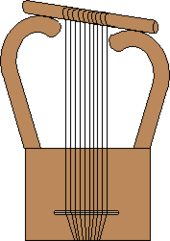| Revision as of 09:35, 16 December 2012 editGuitar hero on the roof (talk | contribs)439 editsNo edit summary← Previous edit | Revision as of 09:38, 16 December 2012 edit undoGuitar hero on the roof (talk | contribs)439 editsNo edit summaryNext edit → | ||
| Line 12: | Line 12: | ||
| }} | }} | ||
| '''Kinnor''' ({{lang-he|כִּנּוֹר}}; also '''Harp of David''') is the Hebrew name for an ancient ] ] mentioned in the ] (] iv. 21) and commonly translated as ]. The instrument was lost and historians ind it hard to give enough information to re-built it. | '''Kinnor''' ({{lang-he|כִּנּוֹר}}; also '''Harp of David''') is the Hebrew name for an ancient ] ] mentioned in the ] (] iv. 21) and commonly translated as ]. The instrument was lost and historians ind it hard to give enough information to re-built it. It probably had similarities to another Jewish instrument called ]. | ||
| ==History== | ==History== | ||
Revision as of 09:38, 16 December 2012
 Representation of a Kinnor David at David's City, Jerusalem Representation of a Kinnor David at David's City, Jerusalem | |
| Other names | Kinnor David, Harp of David |
|---|---|
| Classification | String instrument |
| Related instruments | |
Kinnor (Template:Lang-he; also Harp of David) is the Hebrew name for an ancient Israelite lyre mentioned in the Bible (Genesis iv. 21) and commonly translated as harp. The instrument was lost and historians ind it hard to give enough information to re-built it. It probably had similarities to another Jewish instrument called Nevel.
History



A symbolic representation of the kinnor appears on ancient Hebrew coins. Jubal, the son of Lamech and Adah, is described by the first book of Moshe, Genesis 4:21 as "the father of all such as handle the “kinnor” and “'ugav”"; that is, he was the first musicians and founder of music and the inventor of the “kinnor” or lyre and of the “'ugav” or reed-pipe. The name Jubal is derived from the root "to lead" or "bring forth," "to be fruitful", and the name Jubal suggests likewise “the ram's horn”, and hence music.
The identification of the instrument is uncertain, but a few historians of musical instruments say it is similar to the Greek cithara, Though the Kinnura is a better representation which was in use among the Semitic peoples.
The kinnor has been called the national instrument of Israel.
The viol (lit. "skin") is next to the "kinnor," and was the instrument most used by the Israelites. The hebrew viol is associated with a portable, many-stringed harp. The player sits on the ground, or on a low stool, and holds the viol in his lap. How many strings ("minnim") the instrument generally had is unknown. The later instruments are known to have had twelve strings. The hebrew viol is also compared with the modern Arab santir or the ancient Hebrew Nevel. In modern Hebrew, the word kinnōr refers to a violin and the word nevel means harp.
A collection of hebrew poems entitled "Kinnor Dawid" was published at Wilna in 1863 by David Moses Mitzkun (May 1836 - July 23 1887, Wilna).
See also
References
- Jubilee harps
- "JUBAL ()". The unedited full-text of the 1906 Jewish Encyclopedia. JewishEncyclopedia.com. Retrieved 1 July 2012.
-
 Chisholm, Hugh, ed. (1911). Encyclopædia Britannica (11th ed.). Cambridge University Press.
Chisholm, Hugh, ed. (1911). Encyclopædia Britannica (11th ed.). Cambridge University Press. {{cite encyclopedia}}: Missing or empty|title=(help) - "David's Harp". Dolmetsch Online. Retrieved December 21, 2007.
In Hebrew kinnor, also known as David's harp, is the national instrument of Israel.
- Comp. Josephus, "Ant." vii. 12, § 3
- "VIOL ( lit. "skin")". The unedited full-text of the 1906 Jewish Encyclopedia. JewishEncyclopedia.com. Retrieved 1 July 2012.
- "MITZKUN, DAVID MOSES". The unedited full-text of the 1906 Jewish Encyclopedia. ewishEncyclopedia.com. Retrieved 1 July 2012.
External links
- http://www.rakkav.com/biblemusic/pages/instruments.htm
- Bo Lawergren, “Distinctions among Canaanite, Philistine, and Israelite Lyres, and Their Global Lyrical Contexts,” Bulletin of the American Schools of Oriental Research, No. 309 (Feb., 1998), pp. 41-68.
 Texts on Wikisource:
Texts on Wikisource:
- Chisholm, Hugh, ed. (1911). Encyclopædia Britannica (11th ed.). Cambridge University Press.
{{cite encyclopedia}}: Missing or empty|title=(help) - Gilman, D. C.; Peck, H. T.; Colby, F. M., eds. (1905). New International Encyclopedia (1st ed.). New York: Dodd, Mead.
{{cite encyclopedia}}: Missing or empty|title=(help)
- Chisholm, Hugh, ed. (1911). Encyclopædia Britannica (11th ed.). Cambridge University Press.